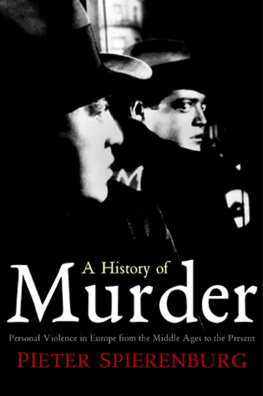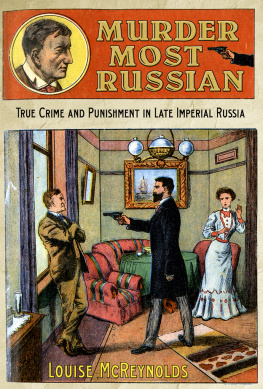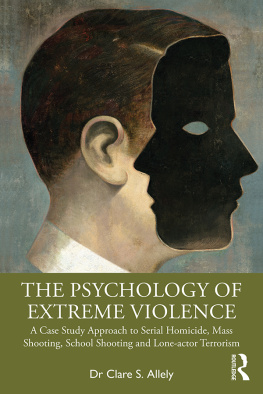A HISTORY OF MURDER
A HISTORY OF MURDER
Personal Violence in Europe from the Middle Ages to the Present
Pieter Spierenburg
Polity
Copyright Pieter Spierenburg 2008
The right of Pieter Spierenburg to be identified as Author of this Work has been asserted in accordance with the UK Copyright, Designs and Patents Act 1988.
First published in 2008 by Polity Press
Polity Press
65 Bridge Street
Cambridge CB2 1UR, UK
Polity Press
350 Main Street
Malden, MA 02148, USA
All rights reserved. Except for the quotation of short passages for the purpose of criticism and review, no part of this publication may be reproduced, stored in a retrieval system, or transmitted, in any form or by any means, electronic, mechanical, photocopying, recording or otherwise, without the prior permission of the publisher.
ISBN-13: 978-0-7456-5863-6
A catalogue record for this book is available from the British Library.
Typeset in 10 on 12 pt Sabon
by Servis Filmsetting Ltd, Stockport, Cheshire
Printed and bound in Great Britain by Biddles Ltd, Kings Lynn
The publisher has used its best endeavors to ensure that the URLs for external websites referred to in this book are correct and active at the time of going to press. However, the publisher has no responsibility for the websites and can make no guarantee that a site will remain live or that the content is or will remain appropriate.
Every effort has been made to trace all copyright holders, but if any have been inadvertently overlooked the publishers will be pleased to include any necessary credits in any subsequent reprint or edition.
For further information on Polity, visit our website: www.polity.co.uk
Acknowledgments

A work of synthesis like this is indebted to all authors upon whose publications I rely, whether I agree with them or not. In addition, the book draws on Amsterdam archival sources; the material was collected during the 1990s with help from several people who were then students: Dsire Herber, Stephanie Reesink, Jeroen Blaak, Janita van Nes, and Aries van Meeteren. Their assistance was financed by the History Department of Erasmus University. I am grateful to the Netherlands Organization for Scientific Research (NWO) for providing me with a grant that set me free from teaching in order to finish the book during the academic year 20067. Michel Porret kindly supplied the material for the opening story of . Jan van Herwaarden and John Najemy alerted me to publications on medieval themes. Ren Lvy and Laurent Mucchielli made available French books not available in Dutch libraries; in addition, Ren secured photographs from the Paris archives. Omri Manoach prepared the graphs. Several colleagues and friends took the time amidst their own activities to read and comment on one or more draft chapters: Clive Emsley, Willem de Haan, Toms Mantecn, Ed Muir, Dorothea Nolde, Paul Schulten, Jim Sharpe, Marty Wiener, and Damin Zaitch. Roger Lane and an anonymous reader commented on the manuscript for Polity. At Polity, my thanks go to Emma Longstaff and Jonathan Skerrett for their assistance, and the copy-editor Sarah Dancy.
The usual caveat that I am solely responsible for the final result applies.
Introduction

Murder is as old as the marks of external violence found on the skulls of prehistoric skeletons. It is with us today and likely to continue to be part of the human experience. More than 100 years ago Frederic William Maitland remarked that, if a fairy were to offer him the opportunity of personally witnessing the same type of scene across societies, he would choose a murder trial, because it reveals so many matters of the first importance. This book examines homicides on record without a trial as well, but Maitlands remark serves for the coming chapters. Killing always affects the fundamental values of those who participate in and witness the act, thus providing valuable information about culture, social hierarchy, and gender relations. In turn, a consideration of broad social change over the long term increases our understanding of the history of killing. Hence, the subject lies at the crossroads of historical scholarship and criminology.
The word murder has the advantage of belonging to everyday language. Most people have a clear idea of what it means. We rarely use it to refer to a soldier shooting an enemy or a traffic accident, whatever our personal views of such events. For that reason, scholars often employ the term murder as shorthand for all forms of private and non-accidental killing. That is the case, for example, in Roger Lanes (1997) overview of the subject in American history. This book conforms to that usage, interchanging murder with the formal concept of homicide just for variation. In the few instances where the reader should understand the former word in a strictly legal sense, this will become clear. Killing is, of course, the most extreme form of personal violence. The scripts of many homicidal incidents are akin to those of violent encounters that do not result in a persons death. Such incidents will be included in our examination, but the focus on murder structures the book. It pays little attention to minor Readers who favor a wider definition of this term may simply insert the word physical each time. Finally, neither violence nor murder should be equated with crime. Their gradual criminalization, in fact, constitutes one of the major themes discussed.
It is only in relatively modern societies that we can apply the category of crime or distinguish between interpersonal violence and state violence. From a world-historical perspective, Johan Goudsblom (1998) distinguishes three sequences of monopolization. First, adult males monopolized violence, excluding women and children from its organized use. The beginning of this hypothetical process coincided with the differentiation between hunting as a male activity and gathering vegetables as a female one. Next, in military-agrarian societies, an elite of warriors monopolized violence, excluding other social groups, mainly peasants and priests. Whereas the earlier situation was rooted in psychological persuasion, the second was reinforced by a related monopoly, that of bearing arms. During the third stage, relatively autonomous warrior elites increasingly had to yield to larger organizations. Violence became monopolized within the framework of the institutions that we now call states. All specialists in organized violence were either incorporated into the state or eliminated. This process gained momentum from the sixteenth century onward, and independently from each other, in North-West Europe and Japan. The subsequent uses of state monopolies include war against other states and, internally, physical punishment, torture, and the forceful restraint of lawbreakers. As in earlier phases, the monopoly remained relative: all assaults and murders, as well as riots and occasional civil war, implied a breach of it, while some states lost their exclusive control on violence
Covering seven centuries, this book takes up the history of murder in Europe when it begins to be possible to distinguish private killing from state violence. The later Middle Ages witnessed the transition from the second to the third phase of monopolization. The oldest reliable evidence about the number of murders, moreover, dates from around 1300. Such evidence forms a crucial basis, but this book goes beyond a study of the frequency of killing. Nor does it jump from one narrative to the other. Instead, it adopts a social scientific perspective, examining patterns in the character, incidence, social meaning, and cultural context of murder. Subthemes such as the representation of violence get attention in passing, but the main focus is on events that actually happened.
Next page





